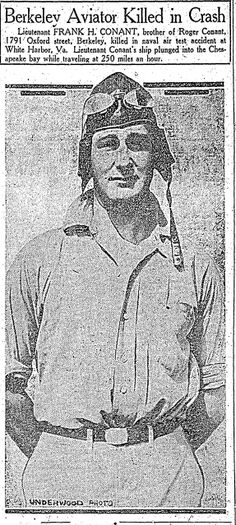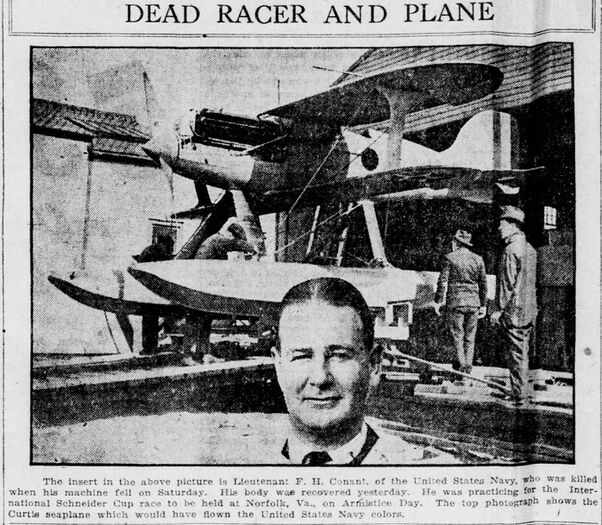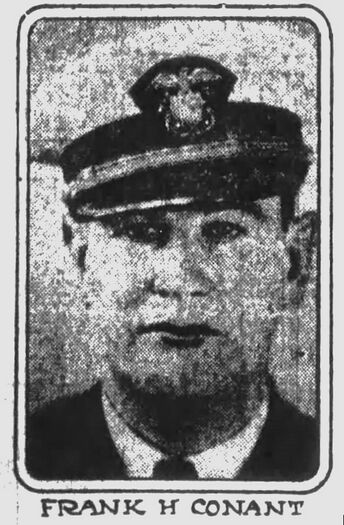FRANK H. CONANT, II, LT, USN
Frank Conant, II '20
Lucky Bag
From the 1920 Lucky Bag:
Frank Hersey Conant, 2d
Berkeley, California
"Hershey" "Monkey" "Rosie"
"HERSHEY" is the irresponsible, irrepressible one who I couldn't find the oars and ate a good but rather informal dinner thereby. Fortunately, however, the affair brought forth no "grave doubts" about him, for as leader of Twenty's "Taint no more Plebes" snake dance, he is a valued relic of the class.
Monkey see—monkey do. There has never been anything pulled off in his presence that he hasn't duplicated or improved on; his healthy imagination works overtime and his actions improve on it.
"Hershey" has proven mighty valuable as a crew man and lack of a few inches of height and reach may be the reason his sweater sports no N crossed-oar.
There is usually some doubt as to just what will happen when he and Doc Harris leave the boat house in a double, but his swimming ability has taken care of him so far.
In some ways Academic life has treated him none too gently. For one thing he claims the routine is just one re-exam after another, but he has always stuck to his guns and finished the fight victorious.
His is the rep of being a real man, alive, and absolutely happy-go-lucky.
Honors: Buzzard; Crew Squad, 4, 3, 1.
The Class of 1920 was graduated in June 1919 due to World War I. The entirety of 2nd class (junior) year was removed from the curriculum.
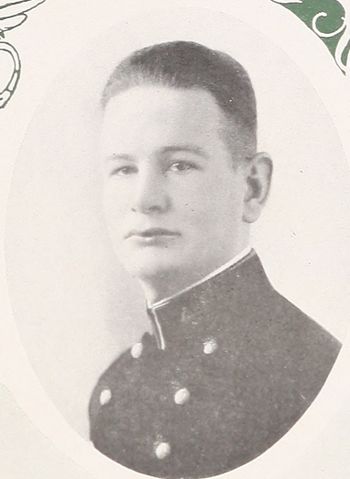
Frank Hersey Conant, 2d
Berkeley, California
"Hershey" "Monkey" "Rosie"
"HERSHEY" is the irresponsible, irrepressible one who I couldn't find the oars and ate a good but rather informal dinner thereby. Fortunately, however, the affair brought forth no "grave doubts" about him, for as leader of Twenty's "Taint no more Plebes" snake dance, he is a valued relic of the class.
Monkey see—monkey do. There has never been anything pulled off in his presence that he hasn't duplicated or improved on; his healthy imagination works overtime and his actions improve on it.
"Hershey" has proven mighty valuable as a crew man and lack of a few inches of height and reach may be the reason his sweater sports no N crossed-oar.
There is usually some doubt as to just what will happen when he and Doc Harris leave the boat house in a double, but his swimming ability has taken care of him so far.
In some ways Academic life has treated him none too gently. For one thing he claims the routine is just one re-exam after another, but he has always stuck to his guns and finished the fight victorious.
His is the rep of being a real man, alive, and absolutely happy-go-lucky.
Honors: Buzzard; Crew Squad, 4, 3, 1.
The Class of 1920 was graduated in June 1919 due to World War I. The entirety of 2nd class (junior) year was removed from the curriculum.
Loss
Frank was lost on October 30, 1926 when the aircraft he was piloting crashed into Winter Harbor, Virginia, on the Chesapeake Bay.
Other Information
From researcher Kathy Franz:
Witnesses heard the buzzing of his Curtiss airplane A-6970, but then the noise stopped, and the plane crashed. He was found strapped in his seat with his parachute on his back untouched and his hand still clutching the control. He may have been flying low at 160 mph when one of his pontoons hit a fish net stake.
Twice the week before, he broke the world’s speed record for a seaplane. However, the record was unofficial as he was keeping the time with a stop watch. On October 26 at Port Washington, he reached a speed of more than 250 miles per hour over a four-and-a-half mile course. The next day at Mitchel Field he attained a speed of 251.5 miles an hour.
Thirteen days later, on November 12, Lieut. William G. Tomlinson (’20) narrowly escaped injury when his Packard-motored Curtiss bi-plane crashed in Little Bay, Norfolk. It was previously flown by Frank at an estimated speed of 258 miles an hour.
Thirteen days earlier, on October 13, The Oakland Tribune printed an article that his mother, Mrs. F. H. Conant, was having a delightful season with Frank in Washington, D. C. She was second vice-president of the Woman’s Army and Navy Club. Members of the club in Oakland had known him as a boy.
The Bulletin, Pomona, California, September 30, 1926:
Navy Speed Ace Hangs Up 156 M. P. H. Average
(By Universal Service) WASHINGTON, Sept. 29. – Lieut. Frank H. Conant, navy speed ace, flew from New York to Hampton Roads, Va., in two hours flat and established a new record, the navy department announced today.
At 2:35 yesterday afternoon, Lieut. Conant took off from Mitchel Field, Long Island. At 4:35 on the dot, he landed at the naval air station at Hampton Roads. The distance in a straight line is 312 miles and required an average of 156 miles an hour. He was flying a service type single seater pursuit plane.
The flight was made under unfavorable weather conditions. In addition to this he had no map. He had secured a blue print, but this was blown away when he passed Barnegat, New Jersey. North of the Delaware capes he encountered a fog. The visibility was so low he could not see the coast line. South of this he ran into a rain storm. He had a new compass, which had not been tested, and afraid to fly a compass course, Lieut. Conant trusted to instinct and a sense of direction, it was stated.
Frank also held the speed record for flight from Philadelphia to Washington. He had more than 1,300 hours in 38 different types of planes. He had been shot from a catapult and was one of the first 25 to operate from the deck of an airplane carrier.
Rear Admiral William A. Moffett, chief of the Navy Bureau of Aeronautics was quoted as saying the Navy has “lost one of its most skillful and resourceful aviators and one of its finest young officers. He is anther pioneer who has made the supreme sacrifice in the service of his country.” Per The Tribune, Scranton, Pennsylvania, November 1, 1926.
In May, 1926, Frank was winner of the race for the observation group in the Curtiss marine trophy races in Allentown, Pennsylvania. In June, he won first place in stunt competition at the New York air races, and in September at the Sesqui-Centennial Exposition in Philadelphia, he won the Bamberger trophy for excellence in military aerial acrobatics.
Frank’s father was born in Massachusetts and died November 17, 1898. While in New York City on court-martial duty, he caught a cold which turned into pneumonia. He was a Navy passed assistant engineer who graduated from Annapolis in 1882. During the Spanish-American war, he served as chief engineer on the Resolute and watched the battle outside Santiago from a short distance. The Resolute assisted in saving many of the crew of the Cristobal Colon.
Frank’s mother was Evalyn (Nugent). She was born July 8, 1862 and died on October 6, 1951. Her ashes are in Mountain View Cemetery, Oakland. Her first husband was a Mr. Van Fleet.
In 1900, she and her sons, Roger and Frank who were both born in Maryland, lived with her parents in Berkley. Her father, Thomas Carr Nugent (1822-1908) died at her home. He served with Captain Peter Simonson in the Civil War and was Placerville’s first postmaster. Her mother was Juliett. In April 1916, Frank’s family had just moved to Placerville when he was nominated to the Naval Academy by Representative John E. Raker. In July 1923, his mother sailed from San Francisco to Honolulu.
From Find A Grave:
Oakland Tribune, November 1, 1926: AIR CHAMPION OF NAVY KILLED
Berkeley Flier, Practicing for International Races, Falls to Death.
WASHINGTON, Nov. 1 – (AP) – The name of another Viking of the air has been scratched from the list of United States Navy. And Lieutenant Frank H. Conant, II, one of America's entries in the coming Schneider Cup speed races, has joined those pioneers who have made the supreme sacrifices in the naval aviation service of their country – the list that includes Chevalier, Lansdowne, Mustin, Chase, Schiff, Rogers and others.
Lieutenant Conant, practicing in a high-speed plane for next month's international cup events at Norfolk, Va., crashed into shallow water at Winter Harbor, 30 miles north of Norfolk, Saturday. His body, strapped to the seat and with his parachute undisturbed on his back, was recovered some seven hours after the accident and will be buried tomorrow at Arlington National Cemetery.
Conant, born at the Naval Academy at Annapolis, November 13, 1898, was graduated there in 1919.
His air experiences comprised more than 1300 hours in 35 different types of ships, including the piloting of a plane shot from a catapult aboard ship. He was one of the first 25 expert "precision" aviators who took off from and landed aboard the flight deck of carrier Langley. He won the Bamberger Trophy for military aerial aeronautics in the national air races in September at Sesquicentennial exposition at Philadelphia, as well as first place in stunt competition at the New York air races last June and the observation group race in the Curtiss marine trophy events here in May.
Lieutenant Conant was flying alone at the time and was enroute from the Anacostia station here at Hampton Roads.
Conant's Brother in Berkeley, Starts East
BERKELEY, Nov. 1 – The body of Lieutenant Frank H. Conant, Jr., naval Schneider Cup racer, will be laid to rest at Arlington National Cemetery tomorrow, while his brother, Roger N. Conant, 1791 Oxford Street, Berkeley, is speeding east to comfort the mother of the dead flyer.
The body of Conant, a former student of the Berkeley high school, who resided with his mother, Mrs. M. F. H. Conant, 1904 University Avenue, were found in the waters of Winter Harbor, Va., yesterday, after a search of twenty-four hours. Conant crashed into the bay, while flying a navy entry for the Schneider Cup race in one of the early trials.
Conant left Berkeley at the age of 14 to accept an appointment to the naval academy, and Mrs. Conant, his mother, followed him east, making her home in Washington. She will return to Berkeley with her son, Roger, who will reach Washington the latter part of this week, too late for the funeral services. The Conant's were related to the late Mrs. John Conant Lynch, an old and well known resident of Berkeley.
Frank was designated Naval Aviator #3047 in 1922.
Photographs
Other
Jimmy Doolittle's autobiography, "I Could Never Be So Lucky Again", mentions Frank as he "thrilled the thousands with spectacular stunts in the pursuit plane…"
He was also mentioned in "Skyward: Man's Mastery of the Air" By Richard Evelyn Byrd Jr.:
The Schneider trophy is given for seaplanes only. The great interest in the 1926 contest rose chiefly from the fact that Italy was a close contender for the cup which had been won twice in succession by Americans.
The U.S. Navy team suffered its first loss when my friend Lieutenant Frank Conant, U.S.N., was drowned just before the contest in a service pursuit plane. He was flying low over Hampton Roads which in places is filled with fish-nets during the season of the race. It is believed that one of his pontoons struck a net mooring stake.
To condemn flying in Conant's plane on the basis of such an accident would be like condemning a make of car because the driver was unfortunate enough to strike a hidden stump in the road.
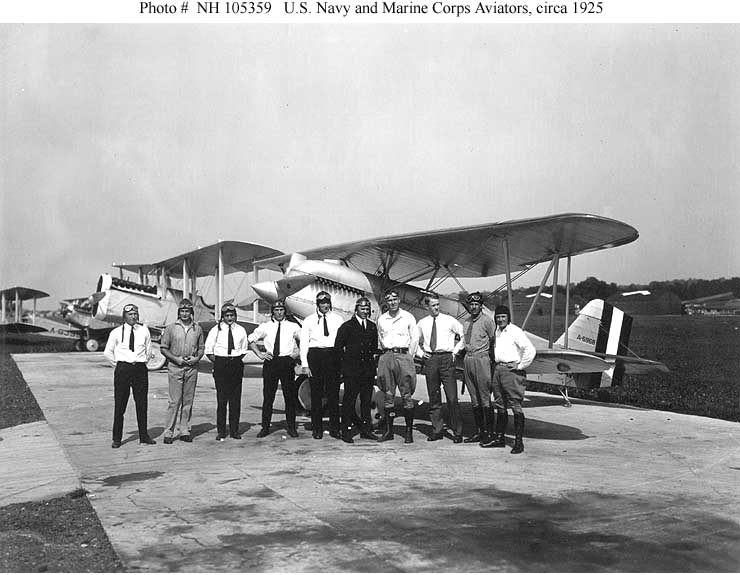
* Lieutenant George R. Henderson, USN, Pilot in the Liberty Engine Builders Trophy Race, 8 October
* Lieutenant Frank H. Conant, USN, Reserve pilot in Schneider Cup Race, 24 October
* Lieutenant Samuel P. Ginder, USN, Pilot in Detroit News Air Transport Race, 9 October
* Lieutenant George T. Cuddihy '18, USN, Pilot in the Schneider Cup Race, 24 October
* Lieutenant Junior Grade Alford J. Williams, USN, Pilot in the Pulitzer Trophy Race, 10 October.
* Lieutenant James D. Barner, USN, Pilot in the Detroit News Air Transport Race, 9 October
* First Lieutenant Ford O. Rogers, USMC, Pilot in the Liberty Engine Builders Race, 8 October
* Lieutenant Thomas P. Jeter, USN, Pilot in the Liberty Engine Builders Race, 8 October
* First Lieutenant Christian F. Schilt, USMC, Pilot in the Detroit News Air Transport Race, 9 October, and
* First Lieutenant Harmon J. Norton, USMC, Pilot in the Pulitzer Trophy Race, 10 October
Related Articles
George Cuddihy '18 was also involved in these air races.
The "Register of Commissioned and Warrant Officers of the United States Navy and Marine Corps" was published annually from 1815 through at least the 1970s; it provided rank, command or station, and occasionally billet until the beginning of World War II when command/station was no longer included. Scanned copies were reviewed and data entered from the mid-1840s through 1922, when more-frequent Navy Directories were available.
The Navy Directory was a publication that provided information on the command, billet, and rank of every active and retired naval officer. Single editions have been found online from January 1915 and March 1918, and then from three to six editions per year from 1923 through 1940; the final edition is from April 1941.
The entries in both series of documents are sometimes cryptic and confusing. They are often inconsistent, even within an edition, with the name of commands; this is especially true for aviation squadrons in the 1920s and early 1930s.
Alumni listed at the same command may or may not have had significant interactions; they could have shared a stateroom or workspace, stood many hours of watch together… or, especially at the larger commands, they might not have known each other at all. The information provides the opportunity to draw connections that are otherwise invisible, though, and gives a fuller view of the professional experiences of these alumni in Memorial Hall.
January 1922
July 1923
September 1923
November 1923
January 1924
March 1924
July 1924
September 1924
November 1924
January 1925
March 1925
May 1925
July 1925
October 1925
January 1926
October 1926

The "category" links below lead to lists of related Honorees; use them to explore further the service and sacrifice of alumni in Memorial Hall.
